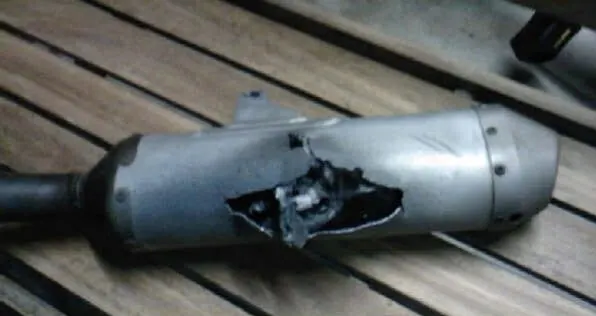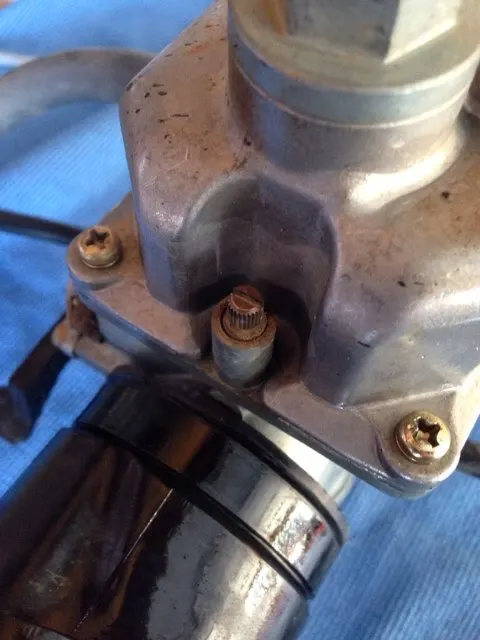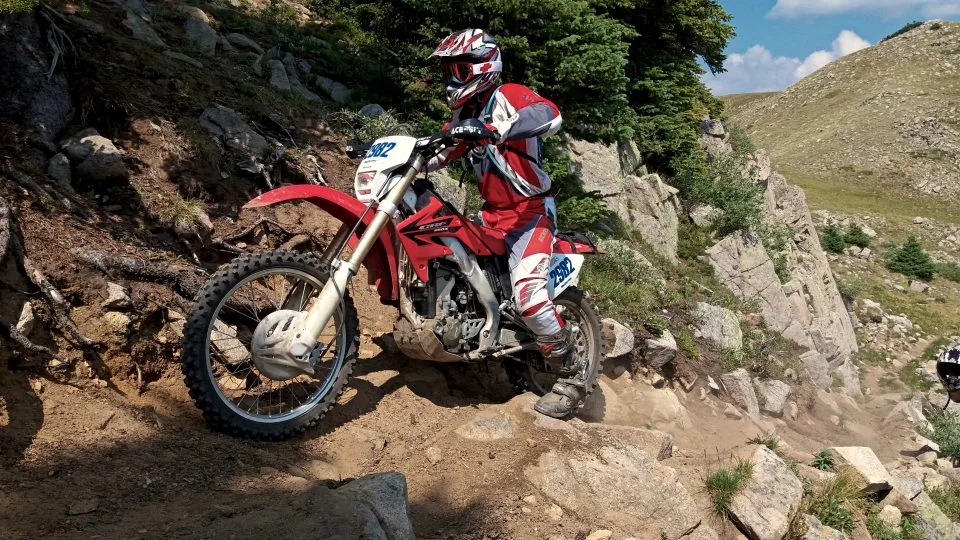Is your dirt bike backfiring and you’re wondering if it’s safe? Whether you have a 2 stroke or 4 stroke dirt bike, you've found the right place!
In this article, I’m going to show you what backfiring is on a dirt bike, why you may or may not need to get it fixed right away, and how to troubleshoot and fix it based on the specific symptoms you’re having.
What is a backfire on a dirt bike?
A backfire is simply an explosion of excess gas, usually in the exhaust, but can also happen in the intake. It's caused by a number of things, such as a lean jetting mixture or a flooded engine.
2 stroke and 4 stroke dirt bikes can both cause backfiring, but it's much more common to hear and see it on a 4 stroke engine.
This is because a 4 stroke typically has higher exhaust gas temperatures, which make it more likely to ignite and combust the gas into an explosion (backfire).

Can a backfire damage your dirt bike?
Depending on how bad your backfiring symptoms are, yes, it can damage your dirt bike. Whether it's a jetting issue that can cause excessive wear on your engine, or a big enough backfire that creates enough pressure to damage the intake or exhaust.
If the backfiring is getting louder or happening more often, you need to stop and get it fixed now before it causes your dirt bike to break down, leaving you stranded in the middle of a trail or desert. You can try and "limp it home", but you should not keep riding it like this.
Why does your dirt bike backfire?
There are a variety of reasons why your dirt bike may be backfiring, but the main reason is that there is not the right amount of fuel getting to or through the engine, and this causes an extra "explosion" that you hear as a backfire.
First, you need to figure out when exactly your dirt bike is backfiring to better diagnose and fix the real problem.
Backfire after changing the exhaust system on a dirt bike
If your dirt bike ran well before but when you modified or upgraded the exhaust, it’s common to have it backfire as a result. Whether it has a carburetor or a fuel injection system, there’s only one way to fix it.
When you swap exhaust systems, the exhaust flows differently - generally more if it’s an aftermarket pipe or muffler. This can cause it to run leaner, which results in backfiring and running hotter.
A fuel injection system will NOT compensate for a different exhaust because it doesn’t measure the exhaust gas temps. So, you need to tune the jetting/fuel mixture to get it to start and run well again.
Backfires But Won't Start
If your dirt bike backfires when starting but won't start, it could be caused by a couple of different issues. Poor jetting for your climate is a likely cause.
However, if you're just trying to start it after an engine rebuild, then there's a chance that something is not installed correctly. If you have a 4 stroke dirt bike, then this could be caused by a camshaft that's not properly timed, so the valves are opening at the wrong time.
Poor jetting causing backfire - lean or rich?
Diagnosing a backfire can be tricky if you're new to troubleshooting because it could be a lean or rich jetting mixture. Depending on your specific symptom, knowing it can help determine which way you need to go.
A backfire when trying to start usually means that there's too much gas in the engine and/or carb. This means that the engine is trying to ignite it but there's too much and it just "pops" some of it away.
Is your pilot jet the right size?
A rich jetting mixture is a common issue when this happens, whether it be too big of a pilot jet or a clogged air filter. If you have a 2 stroke that's backfiring when starting, try leaning out the air screw.
Or if you have a 4 stroke, try leaning out the fuel screw and see if it helps. If it helps but still backfires, then your pilot jet is most likely too big.

Backfiring after kicking too many times
Another common problem is from trying to kick start your dirt bike too many times. If you have a poor starting technique or the carb is a little dirty, this can flood your engine with too much fuel and eventually ignite with a big "backfire" explosion.
This is more likely to happen when the engine is warm. Whether it's poor jetting or a worn engine, just kicking harder isn't going to fix the problem.

Pro tip: If you're out on the trail and have a carbureted dirt bike that floods over, turn the gas off and tip the bike over on its side. This will drain the excess of gas out, then hold the throttle wide open until it starts to get the rest of it out - don't forget to turn your gas back on after it starts! (Ask me how I know, lol)
Backfiring On Deceleration
Whether it’s a “pop”, “bang”, or “crackle”, backfiring when slowing down is fairly common on a 4 stroke dirt bike, but is it safe?
A little bit of popping on deceleration with the throttle closed is okay, but a lot of banging and popping will eventually do some damage. In either case, backfiring when slowing down on a dirt bike is usually caused by lean jetting.
When you close the throttle, the engine is still sucking air and fuel through, but if the pilot jet is too small, not enough fuel will be sucked into the engine. This is why a lean pilot jet circuit causes deceleration backfire.
Backfiring On Acceleration
Trying to twist the throttle but it backfires out of the exhaust pipe? This is often the result of a very rich fuel mixture.
It can cause pretty big flames to shoot out the muffler, which is why USFS-approved spark arrestors are required for trail riding on public trails. If you’re consistently seeing flames, you need to get it fixed.
A rich fuel mixture could be from a jet circuit that’s too rich, but it could also be caused by a weak spark, incorrect engine timing, or a clogged air filter/intake. You need a proper mixture of air and fuel for your dirt bike to start, idle, and run well.
If you ride at different elevations, then I highly recommend you learn how to tune your jetting, whether it’s a 2 stroke carb or a 4 stroke carb. The temp, elevation, and humidity all play a role in how your bike runs.
Backfire through the intake/carb
A backfire through your dirt bike intake or carb is typically caused by a lean mixture. When the engine is starving for fuel, it can ignite the fuel in the carb, resulting in a backfire through the intake.
First, make sure that your carb is getting enough gas to the carb - especially if you just had the tank or carb off. It’s easy to pinch or reroute a fuel line that causes problems.
It’s also possible that you have an air leak in the intake system, feeding the engine too much air. Make sure all the carburetor clamps are properly tightened and there are no cracks in the air boot or intake manifold.
A quick spray of carb cleaner or something flammable around the carb will tell you if there’s an air leak - the engine RPM will change when you spray if there’s an air leak.
Exhaust leak causing a backfire
Exhaust systems are finely tuned, so when they are damaged or not properly sealed they cause problems because it changes the air-fuel ratio going to the engine. There are a few spots you should check first.
Most dirt bike head pipes (or tuned expansion chamber on a 2 stroke) have an o-ring or gasket on the head that bolts to the cylinder or head. If this o-ring or gasket is torn, incorrectly installed, or missing, or the pipe is not on straight, this can cause an exhaust leak and produce backfiring.
Other parts to check for an exhaust leak
While it's not as common, a small hole in the header pipe, mid pipe, or muffler/silencer will cause enough of an exhaust leak that creates a backfire on a dirt bike. You also need to check all of the exhaust system connections.
Where the head pipe and mid-pipe or muffler connect, make sure that the clamp or spring is properly in place and/or tightened. There may also be a gasket that seals in the exhaust - if it's gone or not installed properly, then that might be the cause of your dirt bike backfiring.
What to do when your 4 stroke "flames out"
Flaming out is a common phrase that you might hear someone say when their 4 stroke dies or stalls at low speed and low RPM. This can be extremely frustrating, making it hard to ride tight and technical trails.
To make up for it, you're probably having to slip the clutch more, causing more wear and tear on your bike, as well as creating more heat. This leads to overheating quickly and coolant leaking out the overflow and/or boiling over.
How to fix flameouts on a modern 4 stroke enduro bike
The most common causes are a poor air-fuel mixture or an incorrect idle speed. Some EFI (fuel injected) stroke enduro bikes come from the factory with fuel mapping that's too lean.
This causes the throttle to be snappy or jerky at low speeds, as well as being more likely to flame out (stall). Getting the EFI system remapped by your local dealer or with a fuel tuner/controller can potentially fix your flame-out and backfiring issues.

On carbureted 4 stroke bikes, this can be caused by a lean fuel screw/pilot jet circuit or an accelerator pump that isn't properly tuned. If it doesn't get enough fuel, it will bog and kill the engine, especially if you snap the throttle open quickly.
A flame out could also be as simple as adjusting the idle speed. Modern 4 stroke enduro bike engines are tuned for high RPM riding, so if your idle is below 1800-2000 RPM, this might be causing it to flame out and die/stall.
The most common causes of backfiring on a dirt bike
These are the most common reasons why your 2 stroke or 4 stroke dirt bike is backfiring:
- Rich jetting
- Lean jetting
- Air leak
- Incorrect cam timing
- Weak or loose spark plug
- Clogged air filter
- Worn valves
3 easy steps to prevent engine problems
Many dirt bike riders make the same mistakes that cause catastrophic engine failures. I want to show you the 3 simple steps to prevent major engine problems so that you don’t blow up your bike or get stranded in the middle of nowhere - tap here to learn more.

